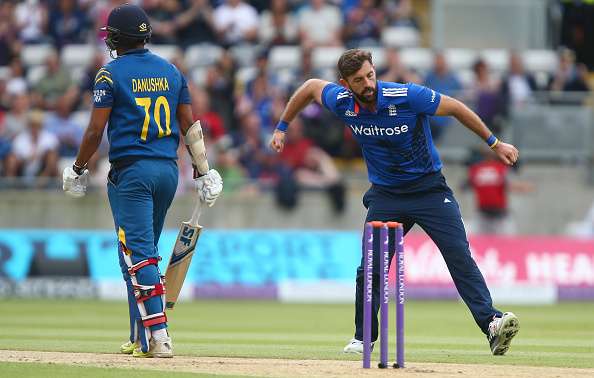It is unlike me to become sentimental, but with England tying the one-day international at Trent Bridge the other night, I couldn’t help it. For one, it rekindled memories of the tied match England had there against Australia in 1989, when the Texaco series was but a blink of the eye in the cricket calendar. But mostly it was because Liam Plunkett, a man who seems to have been frustratingly on the cusp of greatness his whole career, finally got to play the hero, striking the last ball of the match for six to level the scores.
I know others like Jos Buttler and Chris Woakes had laid the groundwork for the face-saving tie with a stirring stand of 138, but had Woakes faced that last ball, I’m not sure the same outcome would have occurred. He looked physically and emotionally drained at that point, which was understandable, but he’d already faced four balls of the final over from Nuwan Pradeep and scored only six of the 14 runs needed for victory.
So, England had the right man on strike, or did they? Throughout his career, Plunkett has perennially been the nearly man. Picked as a strapping fast bowler to ginger up the opposition, he played the first of his 13 Tests against Pakistan in Lahore 11 years ago, only getting his chance when England decided to drop a spinner in a gamble to level the series (it failed).
But he has always been able to bat, and backed himself for glory, as he told disbelievers the other night at Trent Bridge afterwards. Most crucially, he held his nerve, something many who recall the terrible self-doubt he suffered when his bowling went haywire a few years ago might have questioned.
Twenty-five years ago, he would have had to strike the ball dead centre of the bat’s sweet spot to clear long-off as he did. But even though balls ping off bats these days like protons in the Hadron Collider, and players are gym-toned enough to wield them with all the power and malice of a mediaeval mace, a steady head is still paramount in situations like Plunkett faced. And in that, he showed them the maker’s name.
All that was left, then, on that final ball was for Pradeep, who’d hit his yorker length well with his previous deliveries, to err enough so Plunkett could get the ball airborne – four runs not being enough.
I was not privy to the conversation which Pradeep had with Farveez Maharoof and acting captain, Dinesh Chandimal, but it broke Pradeep’s concentration and rhythm. It looked like Maharoof was telling him to bowl a short ball, as the leg-side boundary was longer than the one on the off-side.
That plan was scotched, and he went for another yorker, but the pow-wow had implanted doubt in Pradeep’s mind. The result was a fullish length ball that Plunkett latched on to with the gusto of a man with more than one point to prove.
If it all sounds a bit dramatic, I have seen Plunkett’s travails in close-up over the years. They first came into focus on the 2009/10 tour of South Africa, where he was picked as one of several fast bowlers to fight fire with fire on the quick pitches of the high veldt, or at least that is what he thought.
With Steve Harmison not picked for the tour, Plunkett probably felt he would be England’s enforcer. Instead, they picked Graham Onions to complement Anderson and Broad for the Tests, opting for precision over oppression. Even when Onions got dropped for the final Test, on the fastest, bounciest Wanderers pitch in memory, Plunkett was overlooked for the gentler paced Ryan Sidebottom. It was a bad selection and England were outgunned, which allowed South Africa to level the series.
Plunkett’s frustrations were obvious but instead of whingeing and complaining about his lot, he took his frustrations out in the gym at the Sandton Sun hotel. Every day, sometimes twice, he would pump weights and pound the treadmills like a gerbil on a wheel. He may not have been the happiest, most satisfied player on England’s tour that winter but he was certainly the fittest.
It all began to go badly wrong for him soon after that, as he sought to improve his chances of playing for England by changing his bowling action.
In those days the biomechanical advice, in order to minimise the risk of injury, was to get bowlers square on at delivery with both feet pointing down the pitch. While some took to it, others, like James Anderson and Plunkett, became less effective. Anderson recovered by returning to his old ways but Plunkett got worse after well-meaning advice from a variety of sources saw him trying to please too many masters.
“I started to think about it too much,” he said after he’d battled his way back for a Test recall in 2014. “I used to have a lot of negative thoughts. But if I have them now I just put a positive one next to them. It’s not the end of the world if you do go for four or bowl a wide. You could get a wicket next ball. That’s what you say to kids, isn’t it?”
Although his bowling problems got so bad he could only get a game for the Durham 2nd XI as a batsman, it wasn’t the only setback he had to contend with. His father Alan, already diagnosed with polycystic kidney disease a few years earlier, needed a kidney transplant.
Without hesitation, Plunkett offered him one but father, realising it would probably spell the end of his son’s cricket career, refused. It all ended reasonably well, though. Dad got his kidney and Plunkett got his action back to the point where he is once again in contention for England honours.
Smacking the last ball for six on Tuesday night, while not harming his chances, will not guarantee future selection. With Steven Finn not firing on all cylinders at present, Plunkett is the bowler with real gas in England alongside Tymal Mills, and the latter is strictly white ball only due to a back problem.
At 31, Plunkett probably has two more years of blistering pace left in him before he has to resort to more subtle means of taking wickets. Fast, aggressive and straight with the ball is therefore his passport to more games for England across all formats, with six-hitting a handy sideline for whenever the batsmen aren’t up to it.
This piece originally featured in The Cricket Paper, Friday June 24 2016
Subscribe to the digital edition of The Cricket Paper here












